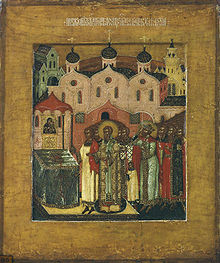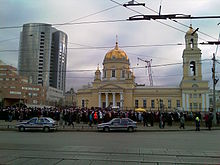- Cincture of the Virgin Mary
-
 Icon depiction the Theotokos giving her cincture to Thomas the Apostle. Below is a styllized representation of Mary's Tomb, with flowers lying on the sarcophagus.
Icon depiction the Theotokos giving her cincture to Thomas the Apostle. Below is a styllized representation of Mary's Tomb, with flowers lying on the sarcophagus.
The Cincture of the Virgin Mary is a relic of the Theotokos (Blessed Virgin Mary) which is venerated in the Orthodox Church. The word "cincture" (Greek: zone) is sometimes also translated as "Belt", "Sash" or "Girdle".
Contents
Tradition
According to the Sacred Tradition of the Orthodox Church, at the time of her Dormition, the Theotokos was buried by the Twelve Apostles in Jerusalem. Three days later, Thomas the Apostle, who had been delayed and unable to attend the funeral, arrived and asked to have one last look at the Virgin Mary. When he and the other apostles arrived at Mary's Tomb, they found that her body was missing. According to some accounts, the Virgin Mary appeared at that time and gave her belt (cincture) to the Apostle Thomas.[1]
Traditionally, the cincture was made by the Virgin Mary herself, out of camelhair. It was kept at Jerusalem for many years, until it was translated to Constantinople in the 5th century, together with the Robe of the Virgin Mary, and deposited in the Church of St. Mary at Blachernae. This relic was embroidered with gold thread by the Empress Zoe, the wife of Emperor Leo VI, (in gratitude for a miracleous cure) and, divided into three sections, is presently kept in a silver reliquary at the Greek Orthodox Monastery of Vateopedi on Mt. Athos.
Placing of the Cincture
During the 12th century, the Emperor Manuel I Komninos (1143–1180) an official feast day for the cincture was established on August 31 on the Orthodox liturgical calendar.
Later, the Emperor John VI Kantakouzenos (1347–1355) donated the cincture to the Holy Great Monastery of Vatopedi on Mount Athos, where it remains to this day, in a silver reliquary of newer manufacture which depicts the Monastery.
Public adoration
In the fall of 2011, the venerated object was brought to Russia to allow Russian Orthodox Christian piligrims to worhip it in different cities. In St.Petersburg[2] it attracted a 2km-long line of people to the Resurrection Nunnery on Moskovsky Prospect virtually blocking automotive traffic on adjacent streets[3], totalling 200 thousand, with Vladimir Putin being among the first ones. The second city was Yekaterinburg where about 150 thousand of people from nearby territories came, including regional governor Alexander Misharin.[4]. The next cities were Norilsk (50 thousand, a quarter of Taymyr Peninsula population) and Vladivostok, the further voyage is planned until the end of November.
References
- ^ Serfes, Father Demetrios; Constantinidis, John (Tr.) (1 March 1999), The Holy Belt of the Theotokos, http://www.serfes.org/orthodox/beltoftheholytheotokos.htm, retrieved 15 January 2010
- ^ Voice of Russia report in English
- ^ (Rosbalt news agency illustrated report in Russian)
- ^ (Russian) n:ru:К Поясу Богородицы приложились 150 тысяч человек в Екатеринбурге и четверть населения Таймыра — Russian Wikinews report
External links
- The Placing of the Cincture (Sash) of the Most Holy Mother of God Orthodox synaxarion and icon
Categories:- Eastern Orthodox liturgical days
- August observances
- Eastern Christian liturgy
- Eastern Orthodoxy
- Liturgical calendar
- Oriental Orthodoxy
- Christian festivals and holy days
- Christian relics
- Marian apparitions
Wikimedia Foundation. 2010.


